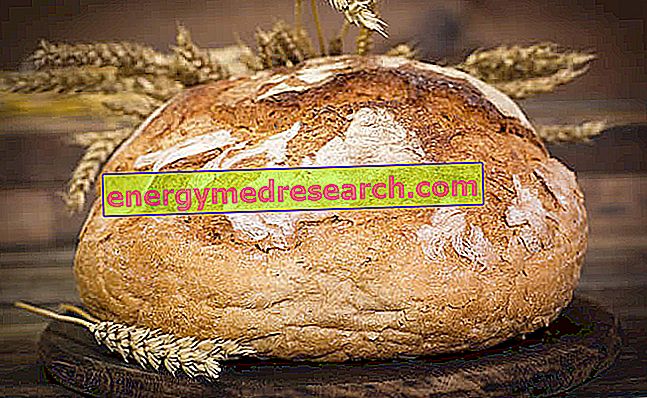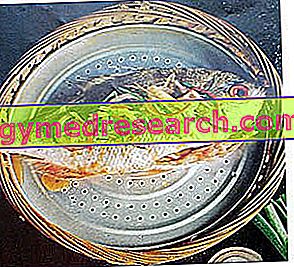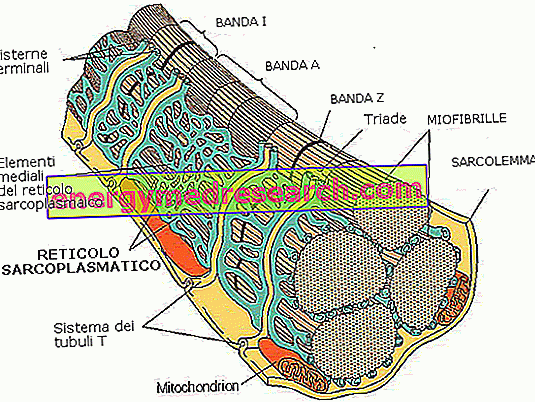Generality
Bread is a product belonging to the III group of foods, or rather that which affects cereals, tubers and their derivatives.
The recipe for bread changes according to the kind of product you want to get. The base is composed of cereal flour containing gluten, raising agents and water; sometimes, there are added fats, salt, sugar and other seasonings.
The bread proper, with the due exceptions, is generally composed of an external crust and an internal crumb. There are different dry and / or unleavened breads, generally flat and circular in shape, which can be crunchy (eg pane carasau, with yeast) or soft but compact (eg tortillas, without yeast).

Types
Bread, in its many varieties, is part of most world diet regimes. They are all different for:
- Type of flour or mixture (type of cereal, level of refining, presence of legume flour or tubers etc.)
- Type of leavening agent (sourdough or sourdough, brewer's yeast, chemical yeast)
- Presence or absence of salt
- Presence or absence of seasoning fats and possibly the type (vegetable oils, lard, butter, milk)
- Presence or absence of other seasonings or ingredients (spices, meats, oil seeds, whole grains)
- Presence or absence of gluten
- Shape and size
- Cooking method (oven, plate, stone).
In general terms, the process for making bread is quite simple. On the other hand, bread making is considered a real discipline; for many, it even constitutes an art.
There are dozens or even hundreds of different types of bread, scattered all over the world. On the other hand, Italy is considered (like few other countries on the old continent) one of the "bread homelands" and boasts as many types as there are places on the entire peninsula.
Very Easy Bread Without Soiling Hands
X Problems with video playback? Reload from YouTube Go to Video Page Go to Video Recipes Section Watch the video on youtubeMaking Simple Bread
As anticipated, the process for making bread can vary quite significantly depending on the type of recipe. However, for beginners who are approaching the world of cooking, it is sufficient to first learn the mechanism and the basic logic.
A good bread is not necessarily the most complicated bread, or the one with the longest process. Furthermore, we recall that, in addition to the type of ingredients, the processes of processing and leavening also contribute to structuring the aromatic and gustatory bouquet of the food. In short, this is a really complicated matter.
As a starting point, it is sufficient to learn how to make simpler bread (leavened); further down, the list of ingredients and the procedure will be summarized in 9 fundamental points:
Ingredients for 800g of bread: 500g manitoba flour, 300ml water, 21% hydrated yeast or 35g dry yeast or 12g brewer's yeast or 3.5g dry yeast, 10g oil, 10g granulated sugar and salt up to 15g; keep a part of flour QB to correct the dough if necessary and to work it.
- Put the flour in a bowl
- In a glass, dissolve the yeast and salt in warm water (about 35Â ° C) with oil
- Make a hole in the center of the flour, add the liquid, mix and knead until the dough becomes smooth and elastic (15-30 ')
- Let rise in the bowl covered with a damp cloth or transparent film at 35 ° C, until the dough doubles in volume (about 60 ')
- Break the dough by kneading again, shape the bread (loaves of 300-500g or loaves of 100g) and place on a baking tray; then cover it and let it levitate in the same way
WARNING! The poor workmanship of the dough, an insufficient leavening and an excessive leavening determine an excessive compactness of the crumb. In the first case, a poor formation of the glutinous network occurs; in the second, the yeasts do not release enough carbon dioxide to inflate it and in the third, by producing too much, they break through, leaving the gases to evaporate outside.
- Dust the loaves with flour or brush with milk or egg yolk and apply a cross cut
- Preheat the oven to 180Â ° C and cook for 25 minutes
- Cook until the external browning; knocking on the loaf, it must sound dull, as if it were empty (due to the rigid crust and internal air chambers)
- Cool on a grill.
Nutritional Features
From the nutritional point of view, due to the nature of its ingredients, bread represents a fundamental element of the so-called Mediterranean diet.
However, it should be remembered that this is a highly caloric food (roughly 220-290kcal / 100g), whose energy essentially comes from complex carbohydrates (starch and malt-dextrin); secondly, proteins with a medium biological value and predominantly unsaturated lipids also contribute to caloric intake. The percentages of the three energy macronutrients vary considerably according to the type of flour, therefore depending on the cereal (or other) and the level of refining.
Depending on the ingredients, the cooking level and the crumb / rind ratio, the bread is characterized by a medium or high glycemic index.
Bread also contains fiber, vitamins and mineral salts; if it involves the use of ingredients of animal origin, even bread can provide cholesterol.
People who are overweight, those with hyperglycemia and / or hypertriglyceridemia must pay attention to the level of bread consumption. If it contains gluten, it must be totally abolished in the celiac diet; less frequent but still noteworthy is the presence of lactose (in milk or butter).



